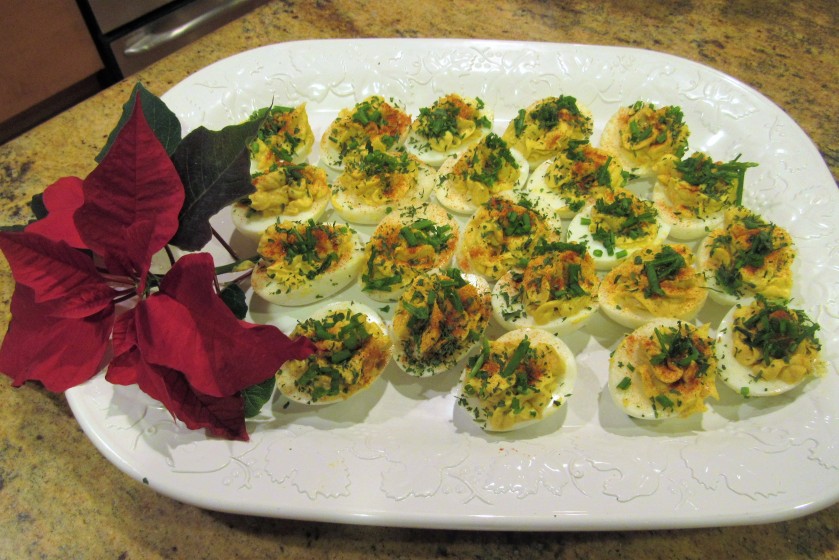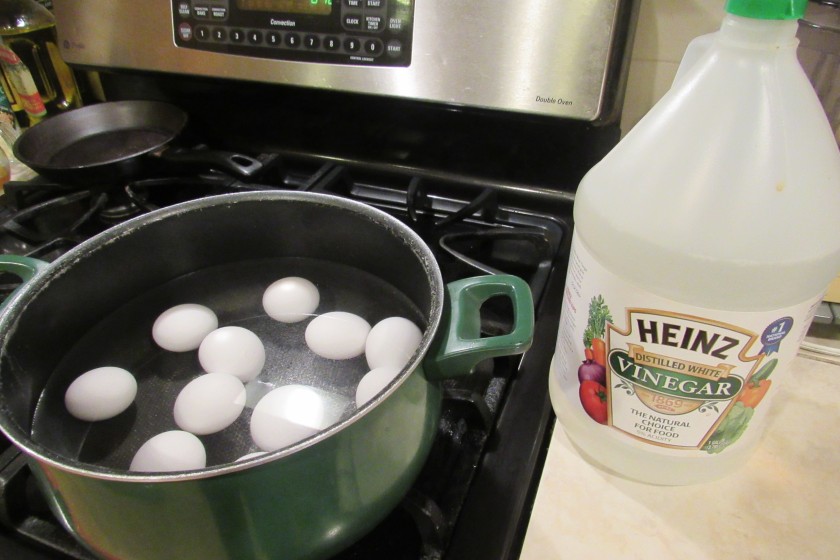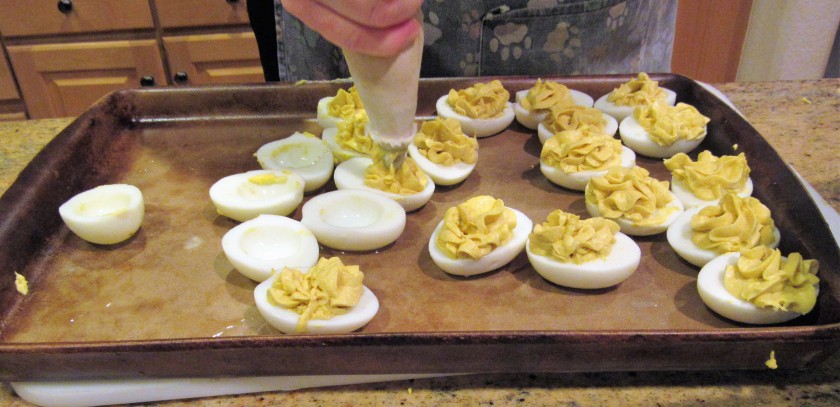Deviled eggs are widely popular the world over and are usually served as a first course. The term “deviled” or “devilled” as it is spelled in the UK, was first used as a description around 1786, but was used to describe foods that were either spicy or zesty in the early 19th century, and the term “deviled” has been used ever since. It seems almost every country has their own version of this tasty holiday favorite. Some recipes and versions are very simple and others are quite elaborate. Deviled eggs go by many names, most of which are translated to mean stuffed eggs. Here in the United States, deviled eggs have many names, such as stuffed eggs, Russian eggs, dressed eggs, and salad eggs, which are all made in the traditional way of mixing the egg yolks with a combination of mayonnaise and mustard and various spices. They are also referred to as angel eggs when they are made with lighter ingredients. In France they are known as oeuf mimosa or mimosa eggs, because they look like the plants from the mimosa tree. Romanians call them oua umplute. In the Netherlands, they are known as gevuld ei. On the island of Malta, deviled eggs are known as bajd mimli, and in parts of South America, they are known as huevos a la peruna or Peruvian eggs. Hungary calls them either toltott tojas, which means stuffed eggs or kazinotojoas or casino eggs. The Hungarian version of these deviled or stuffed eggs mashes the yolks and mixes them with white bread that has been soaked in milk, as well as with the traditional mayonnaise and mustard, and they can be served either as a first course or as a main meal. If they are served as a main meal, they are baked with Hungarian sour cream and are served with French fries. Many European countries refer to deviled eggs as Russian eggs, not because they originated in Russia, but because they are often served on a bed of macedoine, which is sometimes referred to as a Russian salad. In Germany, deviled eggs are often stuffed with a combination of anchovies, cheese and capers. Sweden eats their version of deviled eggs or fylida agghalvor as a traditional dish served at the Easter smorgasbord, where they are mixed with caviar and either cream or sour cream and red onions, and are topped with either chives or dill and anchovies or pickled herring. So as you can see, there are many, many different versions of of what are commonly known as deviled eggs. No matter what they are called or how they are prepared, they are a favorite first course or appetizer served all over the world.
I made the more traditional version of deviled eggs for my husband’s breakfast potluck. Because it was a morning affair, he wanted something that would be more breakfasty than most dishes served at a potluck, so he asked for deviled eggs. Apparently they were a hit. His platter came back empty.

Curried Deviled Eggs
1 dozen eggs
1 TBSP white vinegar
water
1 cup mayonnaise or Miracle Whip
2 TBSP Dijon mustard
2 tsp curry
dash Tobasco sauce
fresh parsley and chives for topping
paprika for topping

Gently place the eggs in a large pan and fill with enough water to completely cover the eggs. Add the vinegar and bring to a boil. Once the eggs have come to a full, rapid boil, let them boil for 12 minutes. If you go longer, the yolks will turn gray and will be a bit tough. After the eggs are cooked, place them in cold after and let them rest for at least 30 minutes before peeling them. To peel the eggs, gently crack them on a hard surface and roll them around a bit to loosen up the shells. Then carefully peel the shells from the eggs. Cut the eggs in half and gently remove the yolks. Place the yolks in a separate bowl and mash them with a potato masher until they are almost a creamy consistency.

Once the yolks are mashed, mix in the mayonnaise or Miracle Whip (I like both, and switch them around all the time, depending on whether or not I want more or less tang to the filling), mustard, curry and Tobasco sauce. You can either whisk everything together or use an egg beater. Try to make sure the mixture is very smooth, and there are no lumps, especially if you are going to pipe the mixture into the egg whites. Then fill the egg whites with the yolk mixture. I usually pipe my yolk mixture into the egg whites. They did not come out as neat as they usually do though. I admit, I was doing them late at night, after a long day, and I was tired, so I still had some lumps in my filling. The lumps kept getting stuck in my piping tip, and then it would just “spit” out the filling. Yes, it happens even to the best of us. C’est la vie mes amies, c’est la vie.

After the eggs were filled I topped them with chopped fresh parsley and chives, then sprinkled them with paprika. This is more of the traditional way to serve them, especially in the United States. They were very festive and colorful and disappeared very quickly once they were served.
Awesome blog you have here but I was curious about if you knew of any community forums that cover the same topics discussed in this article? I’d really love to be a part of community where I can get responses from other experienced individuals that share the same interest. If you have any suggestions, please let me know. Kudos!
LikeLike
I really enjoy the blog.Thanks Again. Cool.
LikeLike
I am so grateful for your article.Thanks Again. Cool.
LikeLike
Very informative article post. Really Great.
LikeLike
Really appreciate you sharing this post.Really looking forward to read more.
LikeLike
Appreciate you sharing, great blog.Really looking forward to read more. Much obliged.
LikeLike
This is one awesome post.Really thank you!
LikeLike
Major thanks for the article post.Really looking forward to read more. Really Great.
LikeLike
I really liked your article post.Really thank you! Really Cool.
LikeLike
Thank you ever so for you blog article.Really thank you! Great.
LikeLike
Thanks for sharing, this is a fantastic post.
LikeLiked by 1 person
My pleasure. 🙂
LikeLike
Really enjoyed this article post.Really looking forward to read more.
LikeLike
I really like and appreciate your article.Really looking forward to read more. Really Cool.
LikeLiked by 1 person
Thank you.
LikeLike
Appreciate you sharing, great blog article.Really thank you! Awesome.
LikeLike
Appreciate you sharing, great blog article. Want more.
LikeLike
I appreciate you sharing this post.Really looking forward to read more. Want more.
LikeLike
Very informative article post. Really Great.
LikeLike
Very good blog post.Thanks Again. Really Cool.
LikeLike
Thanks so much for the blog post.Thanks Again. Awesome.
LikeLiked by 1 person
Thank you ever so for you article post.Much thanks again. Fantastic.
LikeLike
Major thankies for the blog post.Thanks Again. Really Great.
LikeLike
Say, you got a nice blog post.Really thank you! Want more.
LikeLike
Say, you got a nice blog article.Much thanks again.
LikeLike
Major thanks for the article.Thanks Again. Want more.
LikeLiked by 1 person
I truly appreciate this article.Much thanks again.
LikeLiked by 1 person
Thank you ever so for you article post.Thanks Again. Great.
LikeLike
Awesome blog post. Much obliged.
LikeLiked by 1 person
Thank you.
LikeLike
This is one awesome article.Much thanks again. Great.
LikeLiked by 1 person
Thank you. My pleasure.
LikeLike
Say, you got a nice blog article.Thanks Again. Really Cool.
LikeLiked by 1 person
Thank you.
LikeLike
Thanks for sharing, this is a fantastic article.Much thanks again. Will read on…
LikeLiked by 1 person
Thank you.
LikeLike
Great article.Really looking forward to read more. Really Great.
LikeLiked by 1 person
Thank you.
LikeLike
Very neat blog. Want more.
LikeLiked by 1 person
Thank you.
LikeLike
Thanks for the article post.Really looking forward to read more. Great.
LikeLiked by 1 person
Thank you.
LikeLike
I truly appreciate this blog.Much thanks again. Awesome.
LikeLike
Enjoyed every bit of your article post.Really thank you! Really Cool.
LikeLiked by 1 person
Thank you.
LikeLike
Awesome blog post.Much thanks again. Awesome.
LikeLiked by 1 person
Thank you.
LikeLike
I really liked your blog post.Really looking forward to read more. Really Cool.
LikeLiked by 1 person
Thank you.
LikeLike
Thanks for the post.Thanks Again. Will read on…
LikeLike
Major thankies for the blog post.Much thanks again. Great.
LikeLiked by 1 person
Thank you.
LikeLike
Thanks a lot for the article post.Really thank you!
LikeLiked by 1 person
Thank you.
LikeLike
Im grateful for the blog post. Want more.
LikeLiked by 1 person
Thank you.
LikeLike
Thanks a lot for the blog article.Much thanks again. Will read on…
LikeLike
Thank you.
LikeLike
Thanks a lot for the post.Thanks Again. Really Great.
LikeLiked by 1 person
Thank you.
LikeLike
Major thanks for the blog post. Cool.
LikeLiked by 1 person
Thank you.
LikeLike
Muchos Gracias for your article post.Thanks Again. Really Cool.
LikeLiked by 1 person
Thank you.
LikeLike
Hey, thanks for the blog.Really thank you! Want more.
LikeLiked by 1 person
Than you.
LikeLike
I value the article post. Fantastic.
LikeLike
Thank you.
LikeLike
I think this is a real great article post. Cool.
LikeLiked by 1 person
Thank you.
LikeLike
Major thanks for the article. Will read on…
LikeLiked by 1 person
Thank you.
LikeLike
Thanks again for the blog.Much thanks again. Keep writing.
LikeLiked by 1 person
Thank you. Shall do. 🙂
LikeLike